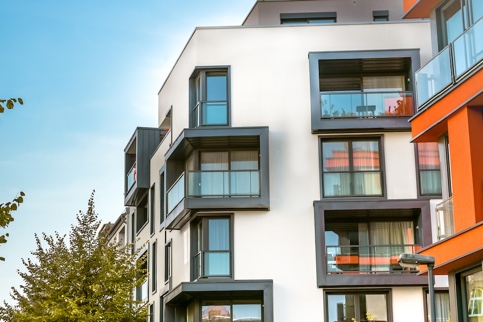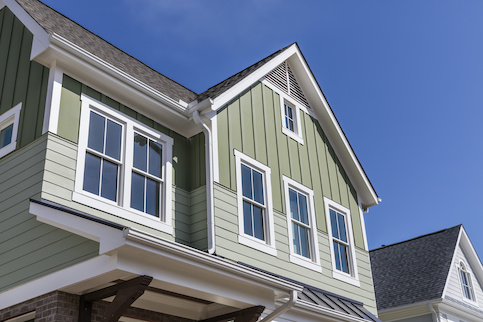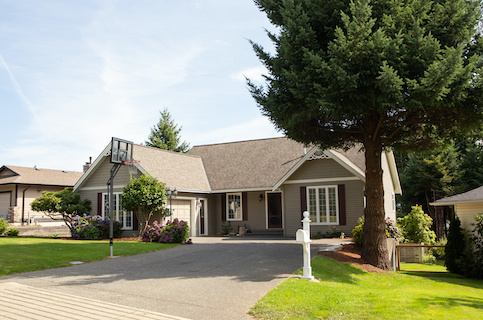Buying a home can be expensive. In addition to the purchase price, home buyers have to prepare for a variety of other expenses – such as closing costs – when they complete the underwriting process and finalize the loan.
While it’s common to pay a single lump sum at closing, some lenders will allow you to finance your closing costs to reduce how much you pay upfront. The same is sometimes possible with a mortgage refinance.
Let’s take a look at how a no-closing-cost refinance works and whether it’s the best option for you if you’re looking to refinance your mortgage loan.
What Is A No-Closing-Cost Refinance?
A no-closing-cost refinance allows you to avoid paying closing costs upfront in a lump sum when closing on your refinance loan. Instead, it rolls your closing costs into your monthly mortgage payments (giving you with a higher principal balance). Alternatively, it may be possible to exchange many of the upfront closing costs for a slightly higher interest rate for the life of the loan.
To be clear, a no-closing-cost refinance doesn’t mean all of your closing costs are forgiven or removed from the transaction. It means they’re dispersed in one form or another across your loan repayment term. As a result, as mentioned, you’ll have a larger principal balance or a higher interest rate.
See What You Qualify For
Buy A Home
Discover mortgage options that fit your unique financial needs.

Refinance
Refinance your mortgage to have more money for what matters.
Tap Into Equity
Use your home’s equity and unlock cash to achieve your goals.
What Is Rolled Over When You Refinance Without Closing Costs?
Closing costs are a collection of expenses that come with purchasing or refinancing a home. These costs are separate from the home’s purchase price. Typically, the costs you’ll roll over when you opt for a no-closing-cost refinance include lender fees, third-party fees, various homeowner fees and the cost of any mortgage points you want to purchase.
Lender Fees
Lender fees will vary depending on your lender and the type of loan you have, but they usually include:
- A loan origination fee (typically .5% – 1% of the loan amount)
- An application fee
- Prepaid interest on your first month’s mortgage payment
Third-Party Fees
Your lender works with other service providers when you get a mortgage, and your closing costs will be used to cover these fees. Some third-party fees include:
- Appraisal fees
- Title insurance premiums
- Credit score report costs
Homeowner Fees
As a homeowner, you may be required to pay several costs – including property taxes and homeowners insurance – ahead of time. Payments on property taxes and homeowners insurance usually go into an escrow account.
If your home is part of a homeowners association (HOA), fees may also be paid to the HOA as part of your closing costs.
Mortgage Points
Your lender might give you the option to pay for mortgage points, also known as discount points. This charge is paid directly to your lender to reduce your mortgage rate and monthly payment. Purchasing mortgage points is commonly referred to as “buying down the rate.”
How Does A No-Closing-Cost Refinance Work?
No-closing-cost refinances can be a good option for borrowers who don’t want to arrive at the closing table with the money to cover closing costs and fees. If you’re concerned about paying a lot upfront when you close, you can potentially choose to pay those fees over time.
The rolled-in closing costs can be spread across your loan repayment term in a couple of ways, which we touched on earlier and will explore in greater detail next.
Your Interest Rate Goes Up
If you don’t pay fees at closing, you likely won’t get the lowest possible interest rate. That’s because your lender will slightly increase your refinance rate to cover the amount you owe in closing costs. Essentially, the extra money from the higher mortgage rate helps repay your closing costs over the long term.
Depending on your current mortgage rate, this might not be as bad as it may sound. For example, if you purchased your home when interest rates were very high and you refinance to a lower interest rate on your new loan, even the higher rate your lender charges to recoup your closing costs could be much lower than your original purchase rate.
Your Loan Principal Increases
With this option, your closing costs are rolled into your principal loan balance. In other words, they’re added to the amount you borrowed from your lender and factored into your monthly payments. While this option doesn’t affect your interest rate, you’ll pay more in interest over the life of your loan since the rolled-in closing costs will increase the overall amount borrowed.
Unless you’re purchasing a home with a Federal Housing Administration (FHA) loan, Department of Veterans Affairs (VA) loan or U.S. Department of Agriculture (USDA) loan and building in certain fees, you can only choose to roll your closing costs into your principal with a refinance. Essentially, you use your home equity to pay for the costs.
It’s important to note that not all lenders offer both of these options for a no-closing-cost refinance. Some lenders may not offer a no-closing-cost refinance at all. Consequently, it’s always best to find out what the lender offers before committing to a no-cost refinance.
Refinance Guide
Learn how refinancing can help you save money.
When Should You Refinance Without Closing Costs?
If you’re planning to sell your home and move within five years, a no-closing-cost refinance might be the best type of refinance to pursue. That’s because you’ll avoid paying closing costs in an upfront lump sum, but you won’t remain in the home long enough to pay more in interest than you saved upfront.
A no-closing-cost refinance might also make sense for homeowners who are looking to renovate their home but don’t have the cash. For them, agreeing to a higher interest rate to avoid closing fees might be less costly than taking out a home equity loan. Borrowers can use a cash-out refinance and avoid closing costs while getting a new mortgage.
Homeowners with an adjustable-rate mortgage (ARM) can use a no-closing-cost refinance to switch to a fixed-rate mortgage. If your interest rate is set to increase soon, a no-closing-cost refinance could help you lower your rate without having to pay closing costs upfront.
Typically, if you plan on living in your home for more than 5 years, the extra interest you pay will eventually exceed the amount you would have paid in upfront closing costs. That means you’ll pay more in time than you would have forked over at closing. How much more depends on your specific loan terms.
Understanding Refinance Fees
When you apply for a refinance, your mortgage lender can provide you with a detailed analysis of your closing costs along with the difference in your interest rate, depending on whether you pay the costs as an upfront fee or over time. Knowing these numbers lets you see how much more you would pay over the life of your loan with a no-closing-cost refinance option.
Example Of Refinance Fees
Let’s say you have $150,000 left to pay on your loan when you refinance, and the lender offers you a 6.75% interest rate and requires you to pay $3,500 in upfront closing costs. Now suppose you have the option to finance the closing costs by paying a higher interest rate of 7.25%.
If you take this option, you’ll end up paying around $5,000 more over a 30-year period than you would’ve paid in upfront closing costs.
Knowing the cost breakdown will help you determine the break-even point – the point where paying the closing costs upfront makes more sense than paying higher interest. Evaluate refinancing costs alongside your budget to determine the best way to hold on to your house without breaking the bank.
You can use our mortgage refinance calculator to look at how different interest rates would affect your monthly payments.
FAQ
Check out the answers to some frequently asked questions about refinancing without closing costs.
The Bottom Line: A Refinance Without Closing Costs Can Be The Right Choice
Financing closing costs over a longer period and paying them upfront both have their benefits and drawbacks. Being certain of your long-term goals and the amount you’re comfortable paying upfront can help you decide which option is best for you.
View Your Refinancing Options
See recommended refinance options and customize them to fit your budget.

Kevin Graham
Kevin Graham is a Senior Writer for Rocket Companies. He specializes in economics, mortgage qualification and personal finance topics. As someone with cerebral palsy spastic quadriplegia that requires the use of a wheelchair, he also takes on articles around modifying your home for physical challenges and smart home tech. Kevin has a bachelor's degree in journalism from Oakland University.












